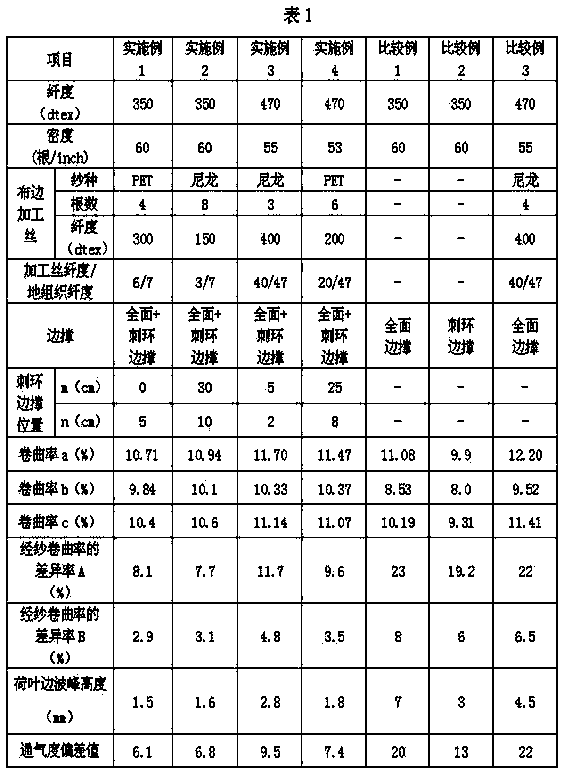Fabric for safety air bag and production method of fabric
A technology of airbags and fabrics, applied in fabrics, vehicle safety arrangements, pedestrian/passenger safety arrangements, etc., can solve the problems of impossible production of high-density fabrics, inability to change the structure of the weave opening, unsuitable airbag cloth production, etc.
- Summary
- Abstract
- Description
- Claims
- Application Information
AI Technical Summary
Benefits of technology
Problems solved by technology
Method used
Image
Examples
Embodiment 1
[0034] Using nylon 66 filament with a fineness of 350dtex, weaving on a water jet loom equipped with full temples and barbed ring temples. Install barbed ring temples at a distance of 5 cm from the two fabric edges and 0 cm from the back of the full temple When weaving, add 4 polyester processed yarns with a fineness of 300 dtex on both sides of the fabric, and finally produce an airbag fabric with a warp and weft density of 60 yarns / inch. The physical properties are shown in Table 1.
Embodiment 2
[0036] Using nylon 66 filament with a fineness of 350 dtex, weaving on a water jet loom equipped with full temples and barbed ring temples, install barbed ring temples at a distance of 10 cm from both sides of the fabric and 30 cm from the rear of the full temple When weaving, add 8 nylon processed yarns with a fineness of 150 dtex on both sides of the fabric. Finally, an airbag fabric with a warp and weft density of 60 threads / inch is obtained. The physical properties are shown in Table 1.
Embodiment 3
[0038] Using nylon 66 filament with a fineness of 470dtex, weaving on a water jet loom equipped with full temples and barbed ring temples. Install barbed ring temples at a distance of 2 cm from the two fabric edges and 5 cm from the rear of the full temple When weaving, add 3 nylon processed yarns with a fineness of 400 dtex on both sides of the fabric, and finally produce an airbag fabric with a warp and weft density of 55 threads / inch. The physical properties are shown in Table 1.
PUM
| Property | Measurement | Unit |
|---|---|---|
| Peak height | aaaaa | aaaaa |
Abstract
Description
Claims
Application Information
 Login to View More
Login to View More - R&D
- Intellectual Property
- Life Sciences
- Materials
- Tech Scout
- Unparalleled Data Quality
- Higher Quality Content
- 60% Fewer Hallucinations
Browse by: Latest US Patents, China's latest patents, Technical Efficacy Thesaurus, Application Domain, Technology Topic, Popular Technical Reports.
© 2025 PatSnap. All rights reserved.Legal|Privacy policy|Modern Slavery Act Transparency Statement|Sitemap|About US| Contact US: help@patsnap.com

